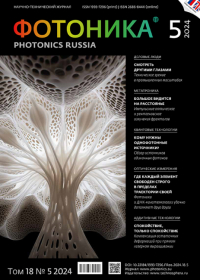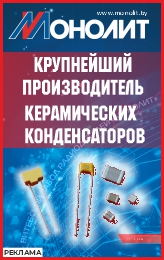Business People
A. A. Grinev
Axe With a Golden Blade DOI: 10.22184/1993-7296.FRos.2024.18.5.348.352
Axe With a Golden Blade DOI: 10.22184/1993-7296.FRos.2024.18.5.348.352
Additive Technologies
A. Yu. Kovchik, A. M. Vildanov, N. R. Alymov, S. Yu. Ivanov, R. V. Mendagaliyev
Application of Residual Deformation Compensation Methods in Direct Laser Deposition of Large-Sized Products DOI: 10.22184/1993-7296.FRos.2024.18.5.406.418
Direct laser deposition is widely used in high-tech industries due to the possibility of creating complex parts, which manufacturing is impossible using traditional production methods. However, the production process is complicating by the formation of residual stresses and deformations in the part, which negatively affect its quality. The field of distribution of stresses and deformations in the part is associated with its geometry. This article presents the main compensation methods of part distortion and describes the types of typical part deformations for DLD. The deformation compensation results are presented on example of four different parts made of stainless steel grade 12Ch18Ni10Ti (analogue AISI 304) and heat-resistant alloy VZh159.
Application of Residual Deformation Compensation Methods in Direct Laser Deposition of Large-Sized Products DOI: 10.22184/1993-7296.FRos.2024.18.5.406.418
Direct laser deposition is widely used in high-tech industries due to the possibility of creating complex parts, which manufacturing is impossible using traditional production methods. However, the production process is complicating by the formation of residual stresses and deformations in the part, which negatively affect its quality. The field of distribution of stresses and deformations in the part is associated with its geometry. This article presents the main compensation methods of part distortion and describes the types of typical part deformations for DLD. The deformation compensation results are presented on example of four different parts made of stainless steel grade 12Ch18Ni10Ti (analogue AISI 304) and heat-resistant alloy VZh159.
Tags: аддитивные технологии газотурбинная установка компенсация деформаций остаточные напряжения и деформации прямое лазерное выращивание
Quantum Technologies
V. G. Krishtop
Single-Photon Sources. Review. Part 1 10.22184/1993-7296.FRos.2024.18.5.376.396
The review discusses various ways to create single-photon sources (SPS). The task of generating single photons can be solved in various ways, and at the moment there is no one among them that would be significantly preferable. An extensive list of literature makes it possible to analyze the prospects for the development of single-photon sources.
Single-Photon Sources. Review. Part 1 10.22184/1993-7296.FRos.2024.18.5.376.396
The review discusses various ways to create single-photon sources (SPS). The task of generating single photons can be solved in various ways, and at the moment there is no one among them that would be significantly preferable. An extensive list of literature makes it possible to analyze the prospects for the development of single-photon sources.
Tags: группировка и антигруппировка фотонов квантовое распределение ключей (крк) кубиты однофотонный источник (иоф) основные платформы для изготовления иоф расщепление по числу фотонов состояния-«ловушки»
Optical Measurements
M. E. Stepanov, U. A. Khokhryakova, T. V. Egorova, K. A. Magaryan, A. V. Naumov
Shedding Light on DNA Origami: Applications in Photonics DOI: 10.22184/1993-7296.FRos.2024.18.5.398.405
Photonics and DNA nanotechnologies complement each other well in a way that DNA nanostructures can be used to build intricate nano-optical systems. The DNA origami method has been particularly successful in creating the building blocks for photonics. Precise positioning of elements at the nanoscale is crucial for manipulating light fields, and this can be achieved by attaching specific nano-objects to a folded DNA molecule in a controlled manner. This review will highlight successful examples of how DNA origami and photonics can collaborate effectively.
Shedding Light on DNA Origami: Applications in Photonics DOI: 10.22184/1993-7296.FRos.2024.18.5.398.405
Photonics and DNA nanotechnologies complement each other well in a way that DNA nanostructures can be used to build intricate nano-optical systems. The DNA origami method has been particularly successful in creating the building blocks for photonics. Precise positioning of elements at the nanoscale is crucial for manipulating light fields, and this can be achieved by attaching specific nano-objects to a folded DNA molecule in a controlled manner. This review will highlight successful examples of how DNA origami and photonics can collaborate effectively.
Tags: гиперусиленное комбинационное рассеяние света днк-нанотехнологии днк-оригами локализованный поверхностный плазмонный резонанс (lspr) люминесценция микрорезонатор микроскопия сверхвысокого разрешения наноскопия наноструктуры плазмоника поверхностно-усиленное крс (sers) эффект парселла
Metatronics
P. P. Maltsev
Pulsed Optical and X-ray Radiation of Fractals: Review of Hypotheses. Part I. Micro Runaway Breakdown DOI: 10.22184/1993-7296.FRos.2024.18.5.358.374
Institute of Microwave Frequencies of the Russian Academy of Sciences, Moscow, Russia
The article presents the study results of the breakdown of fractals of the nano-sized aluminum droplets on the polymer filaments made of carbon benzene rings under a sudden voltage (discharge) of 1.6 kV cm−1 that is similar in magnitude to the electric field of 2.16 kV cm−1 required for the occurrence of micro-breakdown with the runaway electrons during the high-altitude lightning discharges. For the ordinary air breakdown, a voltage of 1–30 kV per centimeter is required. The photographs of radiation shapes in the optical spectral region for two types of breakdowns are provided. The possible reverse of the Doppler effect and Cherenko radiation on the fractal metamaterials is discussed.
Pulsed Optical and X-ray Radiation of Fractals: Review of Hypotheses. Part I. Micro Runaway Breakdown DOI: 10.22184/1993-7296.FRos.2024.18.5.358.374
Institute of Microwave Frequencies of the Russian Academy of Sciences, Moscow, Russia
The article presents the study results of the breakdown of fractals of the nano-sized aluminum droplets on the polymer filaments made of carbon benzene rings under a sudden voltage (discharge) of 1.6 kV cm−1 that is similar in magnitude to the electric field of 2.16 kV cm−1 required for the occurrence of micro-breakdown with the runaway electrons during the high-altitude lightning discharges. For the ordinary air breakdown, a voltage of 1–30 kV per centimeter is required. The photographs of radiation shapes in the optical spectral region for two types of breakdowns are provided. The possible reverse of the Doppler effect and Cherenko radiation on the fractal metamaterials is discussed.
Tags: надповерхностное высокопроводящее состояние плазма полимерные нити из волокна ароматического полиамида фракталы из наноразмерных капель алюминия
News

 rus
rus TS_pub
TS_pub technospheramag
technospheramag technospheramag
technospheramag ТЕХНОСФЕРА_РИЦ
ТЕХНОСФЕРА_РИЦ


